英语教学设计(模板及范例)
英语教学教案模板英文版(10篇)

英语教学教案模板英文版(10篇)英语优秀教学设计篇一英语优秀教学设计篇二英语教案篇三标准英语教案篇十课前预备1、教学挂图。
2、教学投影片。
3、教学录音磁带。
4.6个地点场所的图片及单词卡片(师生各自预备)。
5、第25课交通工具及交通设施图片及单词卡片(师生各自预备)。
6、嬉戏用汽车站牌、交通工具头饰、售票员胸牌、乘车票等。
教学内容A Look, listen and talk.1、本局部利用图画引入单词。
2、学生通过看、听、说,学习5个地点场所的英文表达。
其中school 和zoo两个单词虽然在以前的学习中接触过,但是并未作为正式的单词消失过,此次正式列入生词表中,作为生词消失。
3、本局部单词的要求是:学生能将单词的音和相应的图形联系起来,并能看图用英文说出单词。
4、本局部学习内容的难点如下:(1)book store词组中失去爆破的读音;(2)地点及场所单词词义的识别。
5、初步练习用“Where are you going? Im going to.。
.。
”语句,询问某人要去哪儿和表达自己要去的地方。
6、初步练习询问某人乘坐什么交通工具并能答复。
7、本局部重点学习地点及场所单词的音、形、义/对语句的学习仅要求能初步感知,在B局部教学中应留意进展语句的稳固练习。
8、本局部能够涉及到的复习内容是:询问某物在哪儿的语句及表示方位的词。
此项复习内容为第27课学习指路和问路做了铺垫。
B Lets play and say.1、本局部的学习内容是学生通过嬉戏的方式进展模拟角色表演。
2、学生通过用语言做事情,娴熟把握所学地点场所的单词和询问某人要去哪儿的问答语。
3、本局部有一首关于开着车去某地方的。
歌曲,此歌曲协作学生模拟活动,不要求学生会唱,可以在今后的复习稳固中要求学生逐步学会此歌曲。
教学建议1、学生在学习新内容之前,教师应帮忙学生对第25课的学习内容进展复习。
2、教师出示教学挂图,请学生看图并听录音。
实践英语教学设计模板(3篇)

第1篇一、教学目标1. 知识目标:- 学生能够掌握本节课的核心词汇和短语。
- 学生能够理解并运用本节课的基本语法结构。
- 学生能够了解并运用本节课的文化背景知识。
2. 能力目标:- 学生能够通过听、说、读、写等技能提高英语综合运用能力。
- 学生能够在实际情境中运用英语进行交流。
- 学生能够通过合作学习提高团队协作能力。
3. 情感目标:- 学生能够树立自信心,敢于开口说英语。
- 学生能够培养对英语学习的兴趣,提高学习积极性。
- 学生能够尊重他人,树立良好的国际视野。
二、教学内容1. 课文内容:- 选择适合学生水平的英语课文,确保课文内容与学生的生活实际相联系。
- 课文内容应具有趣味性、实用性,能够激发学生的学习兴趣。
2. 词汇和短语:- 根据课文内容,挑选出本节课需要掌握的核心词汇和短语。
- 词汇和短语应与学生的实际生活相联系,便于学生理解和记忆。
3. 语法结构:- 根据课文内容,提炼出本节课需要掌握的基本语法结构。
- 语法结构应与学生的实际需求相符合,便于学生运用。
4. 文化背景知识:- 结合课文内容,介绍相关的文化背景知识,拓宽学生的国际视野。
三、教学过程1. 导入新课- 利用图片、视频、歌曲等手段,激发学生的学习兴趣。
- 简要介绍本节课的学习目标和内容。
2. 新课导入- 通过问答、小组讨论等形式,引导学生思考课文主题。
- 引导学生回顾上节课的内容,为新课学习做好铺垫。
3. 课文讲解- 集体朗读课文,让学生熟悉课文内容。
- 针对课文中的难点,进行详细讲解,帮助学生理解和掌握。
- 引导学生关注课文中的文化背景知识,拓宽学生的国际视野。
4. 词汇和短语学习- 利用卡片、图片等手段,帮助学生记忆词汇和短语。
- 针对词汇和短语,进行听、说、读、写等技能的训练。
5. 语法结构学习- 通过例句、练习等形式,帮助学生理解和掌握语法结构。
- 引导学生运用语法结构进行造句,提高学生的语言表达能力。
6. 文化背景知识介绍- 结合课文内容,介绍相关的文化背景知识。
小学英语教案模板英文范文

小学英语教案模板英文范文教案小学英语教案模板英文范文教学目标:1. 学生能够掌握本节课所学的单词和句型。
2. 学生能够运用所学单词和句型进行简单的对话。
3. 学生能够通过活动提高英语听、说、读、写能力。
教学重点:1. 掌握单词:apple, banana, orange, pear, grape2. 掌握句型:What’s this? It’s an apple. I like apples.教学难点:1. 学会正确发音和拼写单词。
2. 学会运用句型进行对话。
教学准备:1. 单词卡片:apple, banana, orange, pear, grape2. 图片:apple, banana, orange, pear, grape3. 教学课件教学过程:一、热身活动1. 教师带领学生唱一首英语歌曲,活跃课堂气氛。
2. 教师和学生一起做英语单词接龙游戏,复习已学过的单词。
二、新课导入1. 教师展示图片,引导学生说出图片中的水果名称。
2. 教师板书单词:apple, banana, orange, pear, grape,并带领学生跟读。
三、新课讲解1. 教师讲解单词的发音和拼写,学生跟读并模仿。
2. 教师引导学生用句型:What’s this? It’s an apple. I like apples. 进行对话。
四、课堂活动1. 小组活动:学生分成小组,用所学单词和句型进行对话。
2. 游戏活动:教师带领学生玩“水果猜猜乐”游戏,学生通过听音猜水果名称。
五、巩固练习1. 教师发放单词卡片,学生分组进行单词拼写比赛。
2. 教师发放图片,学生分组进行句型对话练习。
六、课堂小结1. 教师带领学生回顾本节课所学的单词和句型。
2. 学生分享学习心得,教师给予鼓励和指导。
七、布置作业1. 让学生回家后复习本节课所学的单词和句型。
2. 让学生用所学句型写一篇短文,描述自己喜欢的水果。
教学反思:本节课通过图片、游戏、对话等多种形式,激发了学生的学习兴趣,提高了学生的英语听、说、读、写能力。
英语教学教案模板5篇

英语教学教案模板5篇作为一位杰出的教职工,在课前需要做好备课工作,制作教案,教案有助于学生理解并掌握系统的知识。
下面是小编为大家整理的英语教学教案模板,欢迎阅读,希望大家能够喜欢。
英语教学教案模板篇1一、教学资料:module 9 happy brithday unit 1 can i some soup sweets?二、教学目标认知目标1、巩固掌握食物类词汇。
2、掌握句型“can i have some soupsweetsbread?”本事目标能运用“can i have some?”询问他人自我是否能够得到某种食物,并掌握回答:yes,you cansorry,you can′t情感目标让学生经过对课文资料的表演,增强学习的信心,调动学生的学习兴趣。
三、教学重难点重点能用句型“can i have some?””询问他人自我是否能够得到某种食物,并掌握回答:yes,you cansorry,you can′t。
难点句型运用中,与can you?句型混淆。
四、教学设计 step1 warming(热身活动)1、师生互相问好,教师询问是否有人当天过生日或是最近过生日2。
播放录音,全班跟着齐唱英文歌曲’happy birthday to you【设计意图】利用歌曲激发学生的学习兴趣,活跃课堂气氛,同时也拉近了师生的距离,促进了师生的交流。
step2 revision and presentation(新课呈现)1、教师告诉学生amy生日快到了,大家友什么计划为她开一个生日party,事先要准备party上的食物,请同学们帮忙准备一下,在事先准备好的白纸上画出认为party所需准备的食物。
2、教师请学生说出画的是什么食物,多学生语音进行纠正。
3、教师告诉学生:ms smart要为amy准备的食物没有那么多,只需要soup(汤),sweets(糖果),bread(面包),biscuit(饼干),cake(面包),fruit(水果),请画有其中之一种食物的学生举手示意。
英语教学设计【优秀8篇】

英语教学设计【优秀8篇】英语教学设计篇一一、教学目标知识目标:使学生掌握新词first floor, second floor, teachers’ office, library, playground。
使学生了解指令,并作相应的活动,如Go to the library.和Read a book.技能目标:小学四年级学生,通过上册第一单元My classroom学习,他们已经掌握了一些简单与学校设施相关的词汇如:classroom, computer, teacher’s desk等,能够用所学的知识对学校熟悉的事物进行简单描述,为新课学习奠定了基础。
他们学习英语兴趣浓厚,模仿力强,好奇心强,善于表现自己,因而教师注重以学生为主体,激发学生的学习兴趣,引导学生积极参与,注重学生的感知能力培养。
所以,在这节课,教师主要是创设情景,采取小组合作学习的方式,来巩固运用学生已经学习和即将要学习的句型和单词。
情感目标:培养学生学会合作学习和热爱自己学校的良好品质。
二、教学重难点教学重点:掌握有关楼层和学校设施的四个单词和词组,并了解它们的功能。
教学难点:单词library中辅音连缀的发音。
三、教学策略尽管是四年级的孩子,但是也不可能始终保持注意力和学习情趣,所以在这节课中,为了保持孩子们学习兴趣和尽可能地提高学习效率,教师精心准备了一份课件、一份学生校园的图片。
四、教学过程教学环节教学活动设计意图Step 1:热身/复习Warm-up/Revision1、师生共同拍手唱Our school。
Our school这首歌曲尽管是新歌,但是旋律优美,且为孩子们喜闻乐见的音律,所以,听一遍,孩子们即会拍手唱,在上课伊始就让孩子们在很短的时间内进入学习英语学习的氛围之中。
老师自编的Chant,节奏简单,为本节课单词first和second的学习做好铺垫,同时非常自然地进入下一个环节的学习,到Mike的学校去看一看。
英语教案模板范文8篇
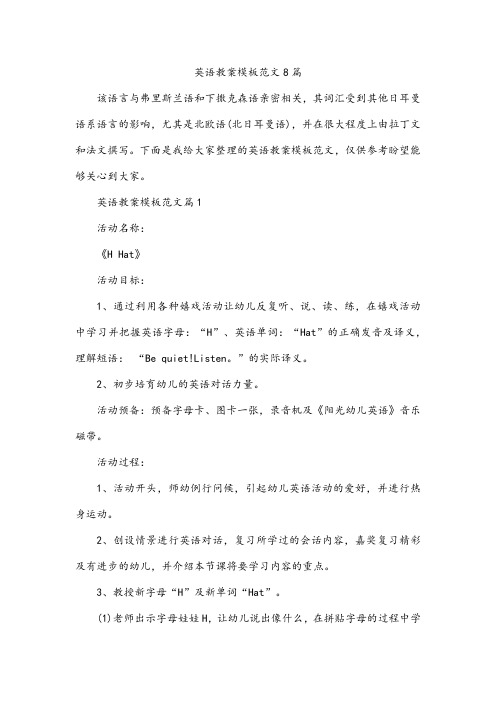
英语教案模板范文8篇该语言与弗里斯兰语和下撒克森语亲密相关,其词汇受到其他日耳曼语系语言的影响,尤其是北欧语(北日耳曼语),并在很大程度上由拉丁文和法文撰写。
下面是我给大家整理的英语教案模板范文,仅供参考盼望能够关心到大家。
英语教案模板范文篇1活动名称:《H Hat》活动目标:1、通过利用各种嬉戏活动让幼儿反复听、说、读、练,在嬉戏活动中学习并把握英语字母:“H”、英语单词:“Hat”的正确发音及译义,理解短语:“Be quiet!Listen。
”的实际译义。
2、初步培育幼儿的英语对话力量。
活动预备:预备字母卡、图卡一张,录音机及《阳光幼儿英语》音乐磁带。
活动过程:1、活动开头,师幼例行问候,引起幼儿英语活动的爱好,并进行热身运动。
2、创设情景进行英语对话,复习所学过的会话内容,嘉奖复习精彩及有进步的幼儿,并介绍本节课将要学习内容的重点。
3、教授新字母“H”及新单词“Hat”。
(1)老师出示字母娃娃H,让幼儿说出像什么,在拼贴字母的过程中学会字母“H”的正确发音。
(2)老师利用图卡引出“帽子”的英语单词,通过嬉戏“贴帽子”让幼儿反复练习强化,渐渐把握单词“Hat”的正确发音及译义。
4、律动教学。
教授幼儿短语“Be quiet!Listen。
”的实际译义及相应的动作。
5、老师小结,嘱咐幼儿:“回家要看VCD,回家要听录音机,回家要当Melody!”英语教案模板范文篇2教学目标:1.能听、说、读、写本课的核心词汇:air, everywhere , alive, smoke,factory, smoke, dirty,clean, plant2.能娴熟把握核心句型:It keeps them high in the sky.3.读懂描述空气污染的对话。
重点难点:1.能在语境中正确使用本单元的核心词汇。
2.能用句型It keeps them high in the sky.描述空气的作用。
教学用具:录音机、自制课件、照片等教学过程:StepⅠWarm up and revision(热身与复习)1. Greetings.2. Guessing game.Step ⅡPresentation and practice (自主探究)1.生词关T: Please write the meanings on your paperair______ smoke ______ factory ________ dirty________ clean ______alive _________ everywhere_______ important ______2. Learn the new words.T: Let’s listen and say the new words.Ss: read these words after teacher.3. Work in groups to read the new words. Recite the new words, and thenrecite in groups。
英语教学案例范文(3篇)

第1篇I. IntroductionIn this English teaching case, the focus is on a unit titled "A Journey Through Time." The aim of this unit is to introduce students to the concept of time travel, its possibilities, and its implications. The target audience is a group of 15-year-old students in a secondary school in China. The lesson duration is 45 minutes, and the teaching methods include a mix of lectures, group discussions, and a creative writing activity.II. Lesson Objectives1. Knowledge Objectives:- Students will understand the basic concepts of time travel.- Students will be able to identify different theories and mechanisms of time travel.- Students will learn new vocabulary related to time, space, and science fiction.2. Skill Objectives:- Students will improve their listening skills through audio clips on time travel.- Students will enhance their speaking skills through group discussions and presentations.- Students will practice their writing skills by composing a short story about their own time travel adventure.3. Emotional and Ethical Objectives:- Students will reflect on the ethical implications of time travel.- Students will develop critical thinking skills by analyzing different perspectives on time travel.- Students will learn to appreciate the importance of history and the present.III. Lesson Materials- PowerPoint presentation on time travel.- Audio clips on time travel theories and experiences.- Handouts with vocabulary related to time travel.- Writing prompts for creative writing activity.IV. Teaching Procedure1. Warm-up (5 minutes):- Begin with a brief introduction to the concept of time travel, asking students if they have ever heard of it or read any stories about it.- Use a simple word association game to elicit words related to time and travel.2. Lecture and Discussion (15 minutes):- Present a PowerPoint presentation that covers the basics of time travel, including:- Theories of time travel (e.g., wormholes, time machines, parallel universes).- Famous stories and movies about time travel.- The ethical implications of time travel.- After each section of the presentation, pause to ask questions and encourage students to share their thoughts and opinions.3. Listening Activity (10 minutes):- Play a short audio clip discussing a specific time travel theory or experience.- After listening, ask students to summarize the main points of the clip and discuss any questions or thoughts they may have.4. Group Discussion (10 minutes):- Divide the class into small groups and assign each group a different aspect of time travel to research (e.g., wormholes, time machines, parallel universes).- Each group will prepare a brief presentation on their topic, which they will share with the class.5. Creative Writing Activity (5 minutes):- Distribute writing prompts that ask students to imagine they have traveled through time and describe their experience.- Give students a few minutes to brainstorm ideas and then ask them to write a short paragraph or two about their time travel adventure.V. Assessment1. Listening and Speaking:- Assess students' listening skills through their participation in the listening activity.- Evaluate their speaking skills based on their group presentations and participation in discussions.2. Writing:- Grade the creative writing activity based on the creativity, coherence, and accuracy of the writing.3. Participation:- Monitor students' participation in all activities throughout the lesson.VI. ReflectionThis lesson effectively introduced students to the concept of time travel, stimulating their interest in science fiction and encouraging critical thinking. The mix of lectures, discussions, and creativewriting activities allowed students to engage with the material in different ways. One potential area for improvement is to provide more resources for students to explore time travel further outside of the classroom. Additionally, incorporating more interactive elements, suchas virtual reality experiences or interactive timelines, could enhance student engagement and deepen their understanding of the topic.第2篇IntroductionThis teaching case focuses on a project-based learning (PBL) approach to enhance student engagement in an English language classroom. The case is set in a secondary school in China, where the target language is English. The students are in their second year of learning English, and the unit of study is "Global Warming and Environmental Protection." The aim ofthis case is to demonstrate how PBL can be effectively integrated into English language teaching to foster critical thinking, collaboration,and real-world application of language skills.BackgroundThe English curriculum in China often focuses on grammar and vocabulary, with limited opportunities for students to apply their language skillsin authentic contexts. This often leads to low engagement and a lack of motivation among students. To address this, the teacher decided to implement a PBL approach for the "Global Warming and Environmental Protection" unit.Objectives1. To encourage students to use English in real-life contexts.2. To promote critical thinking and problem-solving skills.3. To enhance student collaboration and communication skills.4. To raise awareness about environmental issues and the role of individuals in addressing them.Teaching Strategies1. Introduction to PBL: The teacher began by explaining the concept of PBL and its benefits. Students were introduced to the project-based learning cycle, which includes inquiry, planning, execution, and reflection.2. Project Design: The teacher designed a project that required students to research, plan, and present a solution to a real-world problemrelated to global warming and environmental protection. The project was divided into several stages:a. Research: Students were given a list of resources to explore, including articles, videos, and websites. They were encouraged to work in groups to gather information.b. Planning: Each group was required to develop a plan for their project, including the methodology, timeline, and expected outcomes.c. Execution: Students worked on their projects, applying their research findings and creative ideas to develop a presentation.d. Reflection: After completing the project, students reflected on their learning experience, discussing what they had learned and how they had applied their language skills.3. Assessment: The teacher used a variety of assessment methods to evaluate student progress:a. Group work participation: The teacher observed students during group discussions and activities to assess their contribution and collaboration.b. Project presentation: Students were evaluated based on the clarity, coherence, and creativity of their presentations.c. Reflection: Students submitted a written reflection on their learning experience, which was evaluated for depth and insight.Implementation1. Inquiry Stage: The teacher introduced the project by discussing the issue of global warming and its impact on the environment. Students were encouraged to ask questions and express their opinions.2. Planning Stage: Students worked in groups to research different aspects of the project, such as the causes of global warming, itseffects on ecosystems, and possible solutions. They created a timeline and divided tasks among group members.3. Execution Stage: Students presented their findings and proposed solutions in the form of a presentation. They used a variety of multimedia tools, such as PowerPoint, videos, and images, to enhance their presentation.4. Reflection Stage: After the presentations, students engaged in a class discussion, sharing their thoughts and feedback. They also wrote a reflection on their learning experience, highlighting the challenges they faced and the skills they developed.OutcomesThe PBL approach proved to be highly effective in enhancing student engagement and learning outcomes. The following were observed:1. Increased Engagement: Students were highly motivated to participate in the project, showing enthusiasm and curiosity throughout the process.2. Improved Language Skills: Students demonstrated significant improvement in their speaking, listening, reading, and writing skills, as they had to apply their language knowledge in real-life contexts.3. Critical Thinking and Problem-Solving: The project required students to think critically and develop creative solutions to the problem of global warming. They learned to analyze information, evaluate different perspectives, and make informed decisions.4. Collaboration and Communication: Students worked effectively in groups, sharing ideas, and supporting each other. They learned tocommunicate effectively, listen actively, and express their thoughts clearly.5. Environmental Awareness: The project raised awareness about environmental issues, encouraging students to take action in their daily lives to reduce their carbon footprint.ConclusionThis teaching case demonstrates the effectiveness of project-based learning in an English language classroom. By integrating real-world issues into the curriculum and encouraging student-centered activities, teachers can foster a love for learning and develop well-rounded individuals who are prepared to face the challenges of the future.第3篇IntroductionThe communicative approach to language teaching has gained significant popularity in recent years due to its focus on developing students' communicative competence rather than just their linguistic knowledge. This case study examines the implementation of a communicative approach in an English language classroom, focusing on the design and execution of a lesson plan aimed at enhancing students' speaking and listening skills.ContextThe lesson took place in a secondary school in China, where the students were in their second year of studying English. The class consisted of 30 students, aged 14-15, with varying levels of English proficiency. The students were divided into small groups for the duration of the lesson, and the teacher was a native English speaker with three years of experience in teaching English as a foreign language.ObjectivesThe primary objectives of the lesson were as follows:1. To develop students' speaking skills by encouraging them to participate in group discussions and role-plays.2. To improve students' listening skills by exposing them to different accents and intonation patterns.3. To foster a positive and interactive learning environment where students feel comfortable practicing English.MaterialsThe following materials were used during the lesson:1. Handouts with pictures and short texts related to the theme of the lesson.2. A video clip featuring a conversation between two native speakers.3. A set of role-play cards with different scenarios.4. A whiteboard and markers for writing key vocabulary and phrases.Lesson PlanWarm-up (10 minutes)- The teacher greeted the students and briefly reviewed the previous lesson's vocabulary and grammar points.- Students were asked to share their experiences related to the theme of the lesson through a quick discussion in pairs.Presentation (15 minutes)- The teacher introduced the new vocabulary and phrases related to the theme using pictures and short texts on handouts.- The teacher demonstrated the pronunciation and intonation patterns of the new vocabulary, and students were encouraged to repeat after her.Practice (30 minutes)- Group Discussion (10 minutes): Students were divided into groups and given a topic for discussion. They were instructed to use the new vocabulary and phrases they had learned. The teacher circulated around the classroom, listening to the discussions and offering help when necessary.- Listening Activity (10 minutes): The teacher played a video clip featuring a conversation between two native speakers. After the video, students were asked to summarize the main points of the conversation and discuss their opinions on the topic.- Role-Play (10 minutes): Students were given role-play cards with different scenarios. They were paired up and asked to perform the role-plays, using the new vocabulary and phrases they had learned. The teacher observed the role-plays and provided feedback on pronunciation, fluency, and content.Feedback and Evaluation (10 minutes)- The teacher conducted a brief reflection session with the students, asking them to share their experiences and feelings about the lesson.- The teacher provided individual feedback on the students' speaking and listening skills, highlighting their strengths and areas for improvement.- The teacher distributed a short quiz to assess the students' understanding of the new vocabulary and phrases.ConclusionThe communicative approach to language teaching was successfully implemented in this lesson, as evidenced by the students' active participation and improvement in their speaking and listening skills. The use of varied activities and materials helped to create a dynamic and engaging learning environment, making the lesson both fun and effective. The teacher's role in facilitating the learning process was crucial in ensuring that all students had the opportunity to practice and improve their language skills.ReflectionThis case study highlights the importance of adopting a communicative approach in English language teaching. By focusing on communicationrather than just linguistic form, students are more likely to develop their language skills in a meaningful and practical way. The teacher's role in creating a supportive and interactive learning environment is also crucial in encouraging students to take risks and practice their language skills.In the future, the teacher could consider the following strategies to further enhance the effectiveness of the communicative approach:- Incorporating more authentic materials, such as songs, podcasts, and real-life videos, into the lesson plan.- Providing opportunities for students to engage in extended speaking activities, such as debates, presentations, and interviews.- Using technology, such as interactive whiteboards and online platforms, to create more engaging and interactive lessons.By continuously adapting and refining the teaching approach, the teacher can help students achieve their language learning goals and become confident and competent communicators in English.。
英语教学案例范文10篇
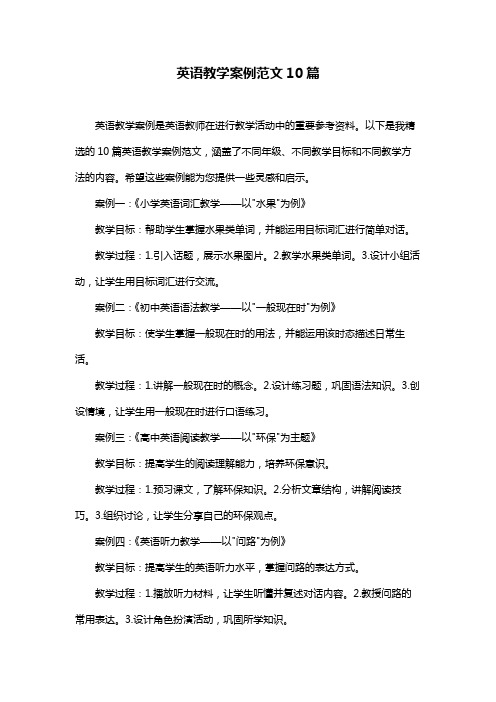
英语教学案例范文10篇英语教学案例是英语教师在进行教学活动中的重要参考资料。
以下是我精选的10篇英语教学案例范文,涵盖了不同年级、不同教学目标和不同教学方法的内容。
希望这些案例能为您提供一些灵感和启示。
案例一:《小学英语词汇教学——以"水果"为例》教学目标:帮助学生掌握水果类单词,并能运用目标词汇进行简单对话。
教学过程:1.引入话题,展示水果图片。
2.教学水果类单词。
3.设计小组活动,让学生用目标词汇进行交流。
案例二:《初中英语语法教学——以"一般现在时"为例》教学目标:使学生掌握一般现在时的用法,并能运用该时态描述日常生活。
教学过程:1.讲解一般现在时的概念。
2.设计练习题,巩固语法知识。
3.创设情境,让学生用一般现在时进行口语练习。
案例三:《高中英语阅读教学——以"环保"为主题》教学目标:提高学生的阅读理解能力,培养环保意识。
教学过程:1.预习课文,了解环保知识。
2.分析文章结构,讲解阅读技巧。
3.组织讨论,让学生分享自己的环保观点。
案例四:《英语听力教学——以"问路"为例》教学目标:提高学生的英语听力水平,掌握问路的表达方式。
教学过程:1.播放听力材料,让学生听懂并复述对话内容。
2.教授问路的常用表达。
3.设计角色扮演活动,巩固所学知识。
教学目标:培养学生的英语写作能力,学会用英语记录生活。
教学过程:1.讲解日记的格式和写作技巧。
2.提供写作素材,指导学生进行创作。
3.互相批改,提高写作质量。
案例六:《英语口语教学——以"旅游"为例》教学目标:提高学生的英语口语水平,学会用英语描述旅游景点。
教学过程:1.展示旅游景点图片,引导学生用英语进行描述。
2.教授相关表达,如:询问景点信息、推荐旅游景点等。
3.组织口语交流,让学生互相分享旅游经历。
案例七:《英语课堂教学游戏设计——以"猜词游戏"为例》教学目标:激发学生学习英语的兴趣,提高课堂参与度。
英语课教案万能模板(共6篇)

英语课教案万能模板〔共6篇〕第1篇:少儿英语教案模板少儿英语教案模板一、Teaching Demands and Aims(教学目的〕二、Teaching important and difficult point (教学重点〕1、words2、sentences3、grammars三、Teaching Aids (教具)四、Teaching procedures(教学过程〕 Greeting(问候〕warm up(热身〕 Review(复习〕 New Leon(新课〕 Step One: Step Two: Step Three: Follow up(叮咛〕五、Homework(作业布置〕作业的布置一、书面作业1、每节课后老师可适中选择课后习题(书本或课外参考书〕及字母作业。
2、低年纪的孩子合适听磁带读课文、画图、连线、写字母等简单作业;每学期两次测试:半期考和期末考试。
3、高年纪的孩子要求抄单词、背单词、背课文等书面作业;每节课前可做适当的听写练习;每个月可做适当的单元测试;期间两次大考:半期考和期末考。
二、磁带作业1、适时布置(条件允答应每周一次〕:将本周学习的内容录进磁带,下周上交。
2、录制要求:首先让学生和老师打招呼,接着报朗读单元,然后录作业内容,最后与老师说再见。
(如:Hello! Amanda.I am Go go.This is Unit 11……… Goodbye! Amanda!)3、听音修正:(1)书面记录:边听边把学生的错音登记在学生手册上。
(2)修正过程:A:打招呼,先表扬肯定,后提出错误,注意错音的跟读B:说悄悄话,增进师生感情交流 C:提出问题。
D:完毕Say:“ Good bye! ”三、教学1、时间安排:每月两次的教学,每生教学时间不超过8分钟。
2、教学内容:(1)本周学习单词及课文的朗读。
(2)词句的翻译。
(3)疑难解答。
(4)家长的经历交流。
第2篇:英语课教案英语课教案范文【篇1:高中英语教案范例】新年第一节英语课〔高一教案〕step i greetings and lead in〔问候以及导入〕1.happy new year!t: well, i am so happy to see you again after the long vacation.i wish everyone of you had a happy holiday.so how about your holiday? had you done some travel? 2.learn some expreions about “dragon”〔学习一些关于中国龙的习语、成语〕 t: this year is the year of dragon, so we will play a gueing game.i will show the english expreions and you try to gue the chinese expreions, long included. step ii revision〔复习〕1.dear, how many words can you still remember after a months winter holiday?2.2.how many phrases can you still remember?3.3.do you still remember the grammar very closely?there is no shortcut in the science road ,only be deligent.在科学上没有平坦的大道,只有不畏劳苦沿着陡峭山路攀登的人,才有希望到达光芒的顶点。
英语教学设计案例(共7篇)

英语教学设计案例(共7篇)第1篇:英语教学设计案例Unit 5 What would you like?重点:能够听懂、会说Let’s talk中的句型难点:理解Help yourself.Mm…yummy.Let me try.Let me show you.等句子发音:句子Help yourself.I can use chopsticks.的发音。
教具准备:1、教材配套的单词卡(餐具和食物)2、教师准备真实的餐具。
2、教材相配套的教学课件[Unit 5 Let’s learn]3、教材相配套的教学录音带教学过程:(一)热身/复习(Warm-up/Revision)教师课前将表示餐具和食物的单词卡片或图片贴在教室四周。
上课后,教师说:Point to the beef/fork…,学生迅速指相应单词图片。
教师说:Pa me fish/Give me vegetables, 学生迅速做出反应,将对应的单词图卡取下,交给教师。
教师播放第四课时Let’s do部分的录音,学生边听边做。
学生以小组为单位,互相发出指令,做动作。
(二)呈现新课(Presentation)教师说:“What would you like for dinner? Chinese food or English food?”学生回答:“I like English food.”“What’s this?”“It’s beef.”“Mm…Yummy.How can I eat it?”“Cut with the e the fork.”“Who can do it?”教师拿出真实的餐具,让孩子试一试。
教师帮助孩子说:“ Let me try.”,请孩子来边试边说。
然后教师边示范边说:“Let me show you.”当孩子们理解了以上的句子,教师带着孩子们边演边说:“Mm…Yummy.I like beef.I can use the fork and the knife.Let me show you.”让孩子在小组中边演边说。
英语课教学设计模板7篇
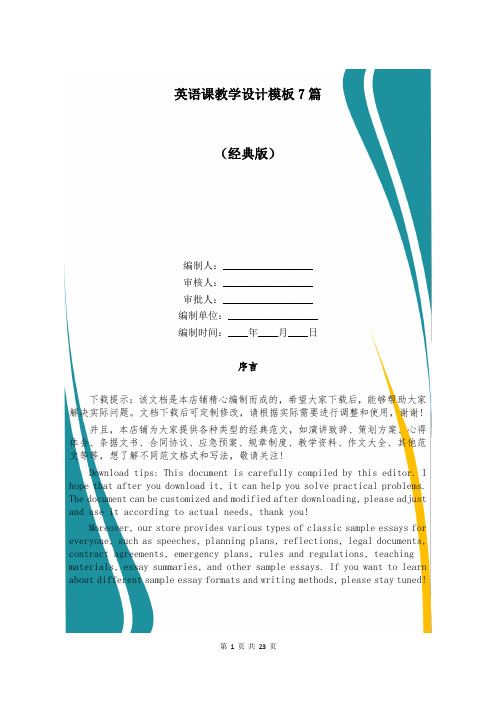
英语课教学设计模板7篇(经典版)编制人:__________________审核人:__________________审批人:__________________编制单位:__________________编制时间:____年____月____日序言下载提示:该文档是本店铺精心编制而成的,希望大家下载后,能够帮助大家解决实际问题。
文档下载后可定制修改,请根据实际需要进行调整和使用,谢谢!并且,本店铺为大家提供各种类型的经典范文,如演讲致辞、策划方案、心得体会、条据文书、合同协议、应急预案、规章制度、教学资料、作文大全、其他范文等等,想了解不同范文格式和写法,敬请关注!Download tips: This document is carefully compiled by this editor. I hope that after you download it, it can help you solve practical problems. The document can be customized and modified after downloading, please adjust and use it according to actual needs, thank you!Moreover, our store provides various types of classic sample essays for everyone, such as speeches, planning plans, reflections, legal documents, contract agreements, emergency plans, rules and regulations, teaching materials, essay summaries, and other sample essays. If you want to learn about different sample essay formats and writing methods, please stay tuned!英语课教学设计模板7篇为了提升大家的教学能力,可以及时将教学设计做好,想必还是有很多人都在为怎么写好教学设计感到发愁吧,本店铺今天就为您带来了英语课教学设计模板7篇,相信一定会对你有所帮助。
2024最新-英语教案模板 2023英语教案模板(优秀9篇)

英语教案模板2023英语教案模板(优秀9篇)要做英语老师,教案一定要会写不会写也要学。
本页是细心的小编为大家整理的9篇英语教案模板的相关文章,仅供参考,希望可以帮助到有需要的朋友。
英语教案篇一材料解说我说的内容是九年义务教育小学英语六年级Book 4 Unit 4 Lesson 19本课主要围绕询问对方正在干什么以及如何回答的英语表达法。
依据小学生英语新课程标准所提出的总目标,根据教材的特点我确定以下教学目标和教学重难点。
模板1、知识目标学生能够会说、认读本课对话并能够使用句型:What are you doing? I’m making a model ship.Pass me an egg,please,Give me two apples.2、能力目标引导学生积极运用所学英语进行表达与交流,学生的多元化只能在交际活动中得以以体现和发展3、情感目标把语言训练融入各种情景之中,学生通过体验,参与活动,学会与他人合作,共同完成学习任务,从而体验成功,培养对语言学习的兴趣。
4教学重难点重点:1)理解并灵活运用句型What are you doing? I’m…2)两个祈使句:Pass me an egg,please。
Give me two apples。
难点:knife、scissors、minute的发音。
以及长句子:We‘ll go to the lake and try it on the water。
5、教具准备课件、录音机和磁带,剪刀,小刀,一页纸,图片等设计方法基于本课的特点和六年级学生好动,好奇,模仿力强,表现欲旺盛等心理特点,我在教法设想和学法指导上坚持以情景话题为核心,以功能、结构为主线,以任务型活动贯穿教学始终,运用直观教学法,情景教学法,全身反应法等教学方法,帮助学生在视听说读唱玩演等饶有趣味活动中,相互合作,体验参与,自主的、愉快的学习英语,发展能力,维持兴趣。
力求做到:“开课能激趣,讲课蕴情趣,练习有兴趣,结束藏意趣”流程1、Warm up(1) Greetings师生相互问候,帮助学生自然进入英语学习状态(2) Sing a song and dance: Front,back,right ,left师生共同唱歌跳舞,既活跃课堂氛围,拉进师生间距离。
英语教学设计模板(汇总8篇)

英语教学设计模板(汇总8篇)英语教学设计模板第1篇教学目标1.能力目标能听、说、认读一些常见的动物单词cat,dog, monkey, duck, panda, rabbit,并能用英语介绍这些小动物。
能听懂一些简单的指示语,并能按照指令模仿动物做出相应的动作。
2.情感目标培养学生爱护动物、保护动物的意识。
教学重难点能听、说、认读一些常见的动物单词cat,dog, monkey, duck, panda, rabbit,并能用英语介绍这些小动物。
能听懂一些简单的指示语,并能按照指令模仿动物做出相应的动作。
教学工具ppt课件教学过程1.Warm-up(1)Free talk(1分钟)a. ---- Good afternoon, Fangfang.---- Good afternoon, Lanlan.b. ---- Hello, Xiaoling. How are you?---- Hi, I'm fine, thank you. And you?---- Very well, thank you.(2)播放歌曲Teddy Bear(要求学生边拍手边吟唱,营造一个欢乐活泼的英语气氛。
)(1分钟)(3)大小声游戏:rabbit, monkey, panda, zoo(1分钟)教师轻声说一个单词,学生则需大声朗读。
教师大声说,学生则轻声说。
(设计思路:活跃气氛,融洽师生情感,激发学生参与课堂活动的热情,使学生迅速进入英语学习的状态,并帮助学生巩固了上节课的单词。
)2.Presentation教师课前在黑板上用彩色粉笔画一个动物园的图案。
(1)教学ducka.教师画一个duck的简笔画,微笑着问学生:Hello, boys and girls. What's this? Do you know?你们认识它吗?它的叫声是怎样的呢?b.课件出现duck的画面及叫声T: Look at my mouth. d-u-c-k, d-u-c-k (注意元音字母u的发音)然后把图片鸭子贴在黑板上。
英语教学教案模板英文版优秀5篇
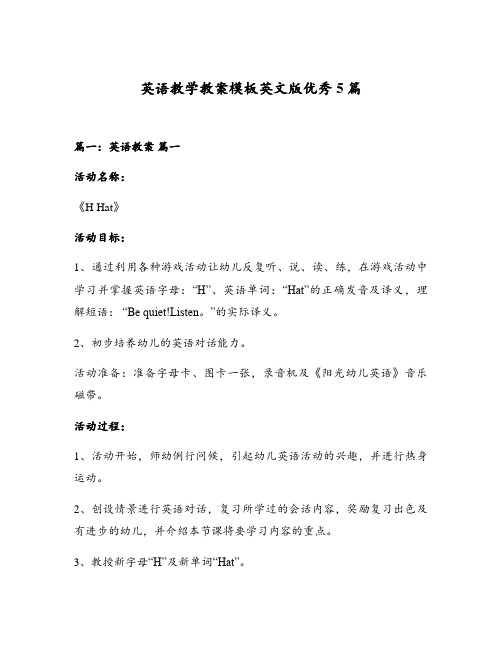
英语教学教案模板英文版优秀5篇篇一:英语教案篇一活动名称:《H Hat》活动目标:1、通过利用各种游戏活动让幼儿反复听、说、读、练,在游戏活动中学习并掌握英语字母:“H”、英语单词:“Hat”的正确发音及译义,理解短语:“Be quiet!Listen。
”的实际译义。
2、初步培养幼儿的英语对话能力。
活动准备:准备字母卡、图卡一张,录音机及《阳光幼儿英语》音乐磁带。
活动过程:1、活动开始,师幼例行问候,引起幼儿英语活动的兴趣,并进行热身运动。
2、创设情景进行英语对话,复习所学过的会话内容,奖励复习出色及有进步的幼儿,并介绍本节课将要学习内容的重点。
3、教授新字母“H”及新单词“Hat”。
(1)教师出示字母娃娃H,让幼儿说出像什么,在拼贴字母的过程中学会字母“H”的正确发音。
(2)教师利用图卡引出“帽子”的英语单词,通过游戏“贴帽子”让幼儿反复练习强化,逐渐掌握单词“Hat”的正确发音及译义。
4、律动教学。
教授幼儿短语“Be quiet!Listen。
”的实际译义及相应的动作。
5、教师小结,叮嘱幼儿:“回家要看VCD,回家要听录音机,回家要当Melody!”篇二:高中英语教学设计篇二一、课程类型:高三复习课二、教学目标:一) 认知目标1、句型和语言点(见教学重点)。
2、用所学的知识与伙伴进行交流、沟通,学会改错、写作。
二)情感目标利用多媒体手段营造积极和谐教学氛围,使学生不自觉地进入情景之中,充分调动学生的思维活动和情感体验,引起学生的共鸣。
三)智力目标在运用语言的过程中培养学生的观察力、分析力、想象力和自学能力,帮助学生加强记忆力,提高思维能力和运用英语的综合能力,激发创造能力。
三、教材分析:这是高三复习阶段的一节写作课。
这节书面表达课就从审题谋篇等方面入手来完成教学目的,侧重于引导学生在把握书面表达的写作前准备即谋篇审题能力,使学生在动手写作前迅速构思按照规范的模式来完成谋篇审题:在教学中不仅仅强调写,对于与写作紧密联系的听、说、读、改错都有兼顾。
小学英语教案万能模板【优秀10篇】

小学英语教案万能模板【优秀10篇】新标准小学英语第四册Module1 Unit1教案篇一module1 unit 1教学目标:1、掌握以下单词的读写,并能熟练使用:nice,a bit,shy,clever,naughty,2、熟练使用句子:this is . he/she is very +adj.3、会用所学的形容词语描述自己、家人和朋友。
教学重难点:1、单词的读音、拼写和运用。
2、形容词在句子中的正确使用。
教学过程:一、greetings.二、duty report.三、warming-up and reviewing.1、sing songs.2、ask and answer.如:t: thin. s: fat.复习(fat,thin,old, young,tall,short,bit,little/small)3. (出示图片)t:this is my friend ms smart. she’s a nice teacher. she’s tall and thin. à 引出课题module 1 friends unit 1 she’s a nice teacher.四:presentation1、呈现新单词:t: look, this is my family. this is my father, he is very nice. this is my mother, she is nice too, but she is a bit shy. this is my little sister, she is thin and very clever. this is my cousin, he is very naughty . we’re happy in the spring festival. (教师把绘制的“全家福”图画贴在黑板上。
)(教读新单词)nice.强调“i”的发音。
2024年英语全英语教案模板8篇
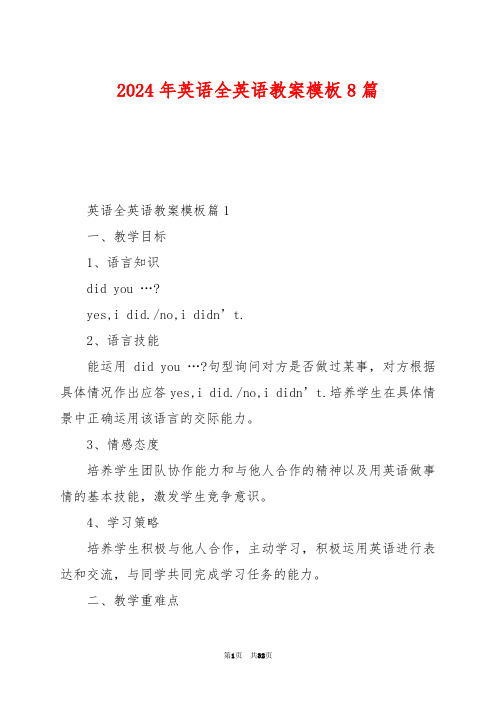
2024年英语全英语教案模板8篇英语全英语教案模板篇1一、教学目标1、语言知识did you …?yes,i did./no,i didn’t.2、语言技能能运用did you …?句型询问对方是否做过某事,对方根据具体情况作出应答yes,i did./no,i didn’t.培养学生在具体情景中正确运用该语言的交际能力。
3、情感态度培养学生团队协作能力和与他人合作的精神以及用英语做事情的基本技能,激发学生竞争意识。
4、学习策略培养学生积极与他人合作,主动学习,积极运用英语进行表达和交流,与同学共同完成学习任务的能力。
二、教学重难点能熟练运用did you …?句型对过去发生的事情进行推测。
Ⅰ.warm-up1.came: ①教师快速出示动词或动词词组,让学生快速做出该动作。
②让学生从另一组动词过去式中找出与图片配对的单词,学习和巩固不规则动词过去式。
如:go-went, meet-met, run-ran, buy-bought, eat-ate, see-saw.2.free talk用“旅游日记”或“假期影集”与组员谈论假日生活。
如:where did you go on vacation?what did you do?did you……?when did you come back?Ⅱ.pre-task1、教师出示提前收集的名胜风景区明信片,提问:“did you go to ……?” did you see……? did you buy……?2、教师出示英国伦敦的名胜风景区明信片,提问:“where did lingling go?”学生回答:“london”.教师问:“where did she go?what did she see/meet/buy?”学生回答后,教师引出课文活动5的歌曲:“listen to a song from amy”,学唱歌曲。
3、[任务呈现]——寄一张风景明信片给你的朋友教师展示伦敦明信片,并介绍:“this is from amy to daming.what did she say? let’s go and see.then please write about your yesterday to amy or your friends.”让我们一起瞧一瞧怎样写明信片呢?Ⅲ.while-task1、播放课文录音,并让学生回答课文活动的问题。
一份完整的英语教案范例

一份完整的英语教案范例一份完整的英语教案范例篇1教学目的:1、知识与技能:本课要求学生能正确听、说、读、单词bathroom,bathtub,dishes,kichen,living room,refigerator,room,shower,sink,stove,toilet,clean,dirty,cook,dry,make,wash,mine,yours。
会口头运用句子:“ What time is it ? It’s ”。
情感态度价值观:1通过复习单词和对话,系统学生的知识体系,激发学生学习英语的爱好。
2 通过小组合作学习,强化合作意识。
3通过情景对话,培育学生学习英语的爱好和综合运用语言的能力。
教学重点、难点:本课重点句子,会正确使用句子。
教具准备:tapes,cards教学过程:Step 1Class opening and Review1) Greeting2) ReviewStep2:Read the wordsbathroom,bathtub,dishes,kichen,living room,refigerator,room,shower,sink,stove,toilet,clean,dirty,cook,dry,make,wash,mine,yoursStep 3Write them.Step4DrillWhat time is it ? It’s _________ ”。
1:45 one forty five2:10 two ten5:37 five thirty seven8:00 eight o’clock3)Extend knowledge :2:10 two ten or ten past two4:30 four thirty or half past three9:00 nine o’clock or nine 教学侧记Step 5An exam一.根据汉语意思写出正确的单词。
英语课程教案范文10篇

英语课程教案范文10篇(经典版)编制人:__________________审核人:__________________审批人:__________________编制单位:__________________编制时间:____年____月____日序言下载提示:该文档是本店铺精心编制而成的,希望大家下载后,能够帮助大家解决实际问题。
文档下载后可定制修改,请根据实际需要进行调整和使用,谢谢!并且,本店铺为大家提供各种类型的经典范文,如工作总结、工作计划、检讨书、演讲稿、心得体会、合同协议、策划方案、作文大全、教学资料、其他范文等等,想了解不同范文格式和写法,敬请关注!Download tips: This document is carefully compiled by this editor. I hope that after you download it, it can help you solve practical problems. The document can be customized and modified after downloading, please adjust and use it according to actual needs, thank you!Moreover, our store provides various types of classic sample essays for everyone, such as work summaries, work plans, review letters, speeches, insights, contract agreements, planning plans, essay summaries, teaching materials, other sample essays, etc. If you want to learn about different formats and writing methods of sample essays, please pay attention!英语课程教案范文10篇俗话说,凡事预则立,不预则废。
小学英语教案全英文版(优秀13篇)
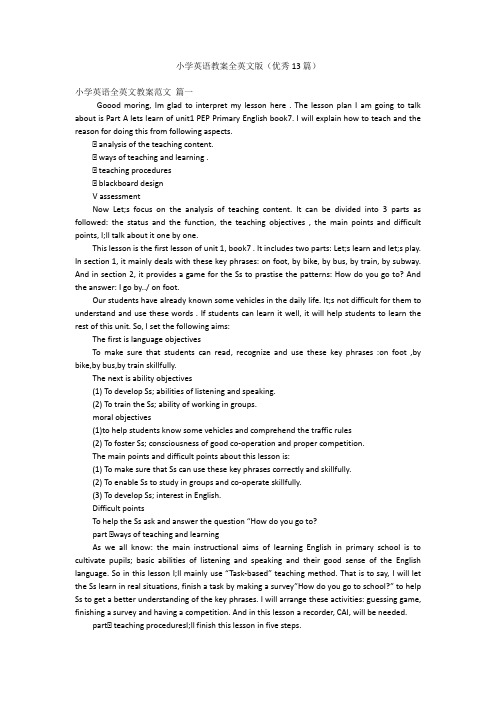
小学英语教案全英文版(优秀13篇)小学英语全英文教案范文篇一Goood moring, Im glad to interpret my lesson here . The lesson plan I am going to talk about is Part A lets learn of unit1 PEP Primary English book7. I will explain how to teach and the reason for doing this from following aspects.Ⅰ analysis of the teaching content.Ⅰ ways of teaching and learning .Ⅰ teaching proceduresⅠ blackboard designV assessmentNow Let;s focus on the analysis of teaching content. It can be divided into 3 parts as followed: the status and the function, the teaching objectives , the main points and difficult points, I;ll talk about it one by one.This lesson is the first lesson of unit 1, book7 . It includes two parts: Let;s learn and let;s play. In section 1, it mainly deals with these key phrases: on foot, by bike, by bus, by train, by subway. And in section 2, it provides a game for the Ss to prastise the patterns: How do you go to? And the answer: I go by../ on foot.Our students have already known some vehicles in the daily life. It;s not difficult for them to understand and use these words . If students can learn it well, it will help students to learn the rest of this unit. So, I set the following aims:The first is language objectivesTo make sure that students can read, recognize and use these key phrases :on foot ,by bike,by bus,by train skillfully.The next is ability objectives(1) To develop Ss; abilities of listening and speaking.(2) To train the Ss; ability of working in groups.moral objectives(1)to help students know some vehicles and comprehend the traffic rules(2) To foster Ss; consciousness of good co-operation and proper competition.The main points and difficult points about this lesson is:(1) To make sure that Ss can use these key phrases correctly and skillfully.(2) To enable Ss to study in groups and co-operate skillfully.(3) To develop Ss; interest in English.Difficult pointsTo help the Ss ask and answer the question “How do you go to?part Ⅰways of teaching and learningAs we all know: the main instructional aims of learning English in primary school is to cultivate pupils; basic abilities of listening and speaking and their good sense of the English language. So in this lesson I;ll mainly use “Task-based” teaching method. That is to say, I will let the Ss learn in real situations, finish a task by making a survey”How do you go to school?” to help Ss to get a better understanding of the key phrases. I will arrange these activities: guessing game, finishing a survey and having a competition. And in this lesson a recorder, CAI, will be needed.partⅠ teaching proceduresI;ll finish this lesson in five steps.step1 lead--in activitiesI will begin my class with drawing and guessing game, just like this : I show students some vehicles such as bike ,bus ,jeep which they learned before by Stick Figures and ask them guess what;s it.Purpose: It is important to form a better English learning surrounding for the Ss by guessing game. and at the same time it provides situations to review learned knowledge for the next step.step2 prestentationNow I;ll mainly talk about this step.1、first there is a Free talk between T and Ss. For example: I show many pictures of beautiful cities and ask students some questions, such as do you like this city?where do you want to go ?and help Ss to answer them with by train ,by plane,by ship.By the way, I show the picture of a school, and say“ I go to schiool by bus” ,Ss read this sentence. do the actions and ask how do you go to school?,show many pictures of tools such as ,on foot by bike ,by bus to help students answer my question one by one.To present the key structures one by one is much easier for the Ss to learn and grasp the meanings.2 With the help of the CAI I set a situation to help Ss understand the way of using these key phrases:A boy is coming, who is going to school. He says: I go to school byThen play the sounds of bus, bike ask students to listen carefully and tell “I go to school by according to the different sounds, by the way , I present another new phrases:by subwayPurpose:Make Ss use these new phrases with sentence structures, to help Ss use the language in a real situation.step3 practise3 I order to make every student read these new phrases correctly, I design a drill in this step,I show cards as soon as possible ,students should read the words quickly and spell them. Then I ask How do you go to school?students answer I go to ......also I will quicken the speed to ask .The purpose is to draw the whole studentsattention to the spelling of the words4 After this, I ask Ss to do Lets play in fours. They use places cards and vehicle cards, ask and answer:How do you go to ? I go to by”5, If Ss can ask and answer expertly, I will ask them to make a short dialogue.the purpose of this is to help students to learn those sentenses through a ture situation and make the dialogues in order to check if Ss can usse these key prases、sentences structures skillfullystep 4 consolidationlet students do a survey about how do you go to school?and the table like this :write down names and tools another Ss chooseTask-based teaching method is used here to develop Ss; ability of ; communication and also their ability of co-operation will be well trained.step 5 homeworkask students to collect other kinds of transport tools through the library ,computer.the purpose of this is to stimulate the interest of learning english and to wide the studentsknowledgestep6 blackboard designmy blackboard design like this :on the left Ishow the phrases:on foot,by bus.......on the right there are many sentences:how do you go to school?I go to ......step 7 assessmentdue to the studentsage ,I make every students work in class through many activities in order to stimulate the studentsinterest and provide they a wide thinking room. I make students learn this lesson very well through desiring scene statuesthats all,thank you for your listening !Unit 1 Lesson 篇二Part A Let;s say, Let;s chant Part C CultureTeaching Aims :1、Be able to listen, say, recognize the words: apple, ant, boy, bag, Coke, coffee.2、Be able to listen, say, read and write these three letters: A a; B b; C c3、Through the chant review the letters of ABC, train a sense of group identity.Focus Points amp; Difficult Points :Read the letters: Big letter C, small letter c; Write down them correctly and handsomely.Teaching Preparation:1、Letter cards ,some word pictures, word cards: apple boy eraser ant crayon body head cake Coke coffee bag ball2、A little blackboard with four-line format and a ball.Designing for the blackboard:panda beaver eagle kangaroo (pictures)China Canada America Australia (words)Teaching Steps:Step1. Warm ndash;up1、Sing a song.2、Free talkT: Hello. I;m Wendy. I;m from Hangzhou.S1: Hello! I;m 。
英语教案详案范文5篇

英语教案详案范文5篇(实用版)编制人:__________________审核人:__________________审批人:__________________编制单位:__________________编制时间:____年____月____日序言下载提示:该文档是本店铺精心编制而成的,希望大家下载后,能够帮助大家解决实际问题。
文档下载后可定制修改,请根据实际需要进行调整和使用,谢谢!并且,本店铺为大家提供各种类型的实用资料,如工作总结、工作报告、工作计划、心得体会、讲话致辞、教育教学、书信文档、述职报告、作文大全、其他资料等等,想了解不同资料格式和写法,敬请关注!Download tips: This document is carefully compiled by this editor.I hope that after you download it, it can help you solve practical problems. The document can be customized and modified after downloading, please adjust and use it according to actual needs, thank you!Moreover, our store provides various types of practical materials for everyone, such as work summaries, work reports, work plans, reflections, speeches, education and teaching, letter documents, job reports, essay summaries, and other materials. If you want to learn about different data formats and writing methods, please stay tuned!英语教案详案范文5篇教案是可以让教师更加合理发挥教学水平的文件,写教案的过程是提高教学研究能力的过程,下面是本店铺为您分享的英语教案详案范文5篇,感谢您的参阅。
- 1、下载文档前请自行甄别文档内容的完整性,平台不提供额外的编辑、内容补充、找答案等附加服务。
- 2、"仅部分预览"的文档,不可在线预览部分如存在完整性等问题,可反馈申请退款(可完整预览的文档不适用该条件!)。
- 3、如文档侵犯您的权益,请联系客服反馈,我们会尽快为您处理(人工客服工作时间:9:00-18:30)。
一、教材分析:Analysis of the Teaching material
二、教学目标:Teaching alms and demands:
三、教学重难点:Teaching keys and difficulties:
四、教学方法:Teaching methods:
五、教学工具:Teaching aids:
六、教学过程:Teaching procedures:
七、板书设计:Blackboard Design.
八教学评价与反思
一份正规的高中英语教案主要应该包含上面的八个要点,也是作为一份教案应该具有的基本格式。
《Making Apologies》说课稿
关于课文
本篇课文选自中等职业技术学校教材《基础英语》第一册。
教学目标和要求
本课是第2课时,教学目标主要是对课文中的对话进行阅读、巩固和拓展。
要求通过学习,学生能达到以下要求:
1.知识目标
能够牢固掌握好课文对话中的重点词汇词组;阅读对话并且根据提示完成对话,运用已经学会知识让学生分角色进行口语练习,特别要求记忆Sarah所说的话并能当堂表演对话。
能够拓展对话,根据图片内容创作一段对话。
2.能力目标
能够独立阅读课文对话,能够正确理解课文对话并根据提示完成对话,能够用英语表达歉意和接受道歉并学会为工作中所犯的错误致歉。
能够拓展对话,完成看图说话并把每张图片的对话内容连在一起形成一段对话。
3.情感目标
通过小组讨论,培养同学们的交际能力和团队合作精神;
不同的教学目标和要求
A. 对于基础相对好的同学,能够阅读对话并且根据提示完成对话,运用已经学会知识让学生分角色进行口语练习,能当堂表演对话,能够拓展对话,根据图片内容创作一段对话。
B. 对于基础中等的同学,能够完成课文对话,分角色进行口语练习,能当堂表演对话。
C. 程度较弱的同学,要求能够熟练掌握课文中的生词和词组,能够正确完成课文对话。
教学重点
英语道歉和接受道歉的词汇及表达;学习英语在工作中犯错误的表达;根据提示完成对话;表演对话;
教学难点
根据提示完成对话,表演对话,拓展对话,根据图片创作对话。
学情分析
该班部分学生英语基础比较好,部分比较薄弱,学习的主动性参差不齐,性格普遍也比较内向。
教学指导思想
鉴于以上情况,本人在教学活动中采用任务型教学,充分调动学生学习的主动性,积极性,自觉性,充分体现课堂上学生为主,教师为辅,师生互动的指导思想,让每一个学生都能“动”起来,不同层次的学生都能有一定的提高。
教学活动
热身练习:整堂课的教学活动设计是由易到难的。
先复习上节课所学到的表达道歉和接受道歉的句型,要求学生能回顾出英语的表述形式,为之后的教学活动先做一个热身练习。
活动一:work in pairs to discuss how to express your apologies to someone for doing wrong things and how to accept an apology,write on the board the sentence patterns.
活动二:learning words and expressions, then do words exercises
活动三:Complete the conversation of the text by using the words given as clues Background introduction of the conversation:
Sarah : the secretary of Mr. Black
Mr.Black: the general manager of the company
在sarah 准备的一份文件中,Mr. Black发现了打印错误:去年产品的产量应该是28,000,而不是23,000。
因为这份报告要提交董事会,所以Mr.Black不希望有任何差错Encourage the students to read the text, then try to find their answers.
活动四:Let the students read the text again, then role-play the conversation with their partner
1)组织学生两人一组练习对话
2)让各组学生分角色进行练习对话,要求特别记忆Sarah所说的话
3)选择几组学生进行当堂表演
活动五:Language points in the conversation
1)find some mistakes 发现错误
2)make mistakes 犯错误
3)all the details to be correct 被纠正的细节
4)accept my apologies 接受我的道歉
5)such a short time 如此短的时间
6)I realize how hard it was for you to finish the report within such a short time. 我意识到让你在如此短的时间内完成报告是多么难啊
7)This won`t happen again. 这个不会再次发生了。
活动六:Complete the task (wok in groups )
Class work :Make a conversation on the basis of each of the pictures. Then put them together.
教法
本节课采用的是互动(interactive)、交流(communicative)等教学方法,教学中以学生为主体。
学法
课堂教学以学生为主体,尽可能给学生多一些活动的余地,多一些表现自我的机会,多一份尝试成功的喜悦,让学生自始自终参与到知识形成的全过程中,将“一言堂”变成“群言堂”,让他们通过合作学习法(cooperative learning)、互动学习法(interactive learning)来完成课堂任务。
《Making Apologies》教学设计
Teaching Aids: Multi-media。
